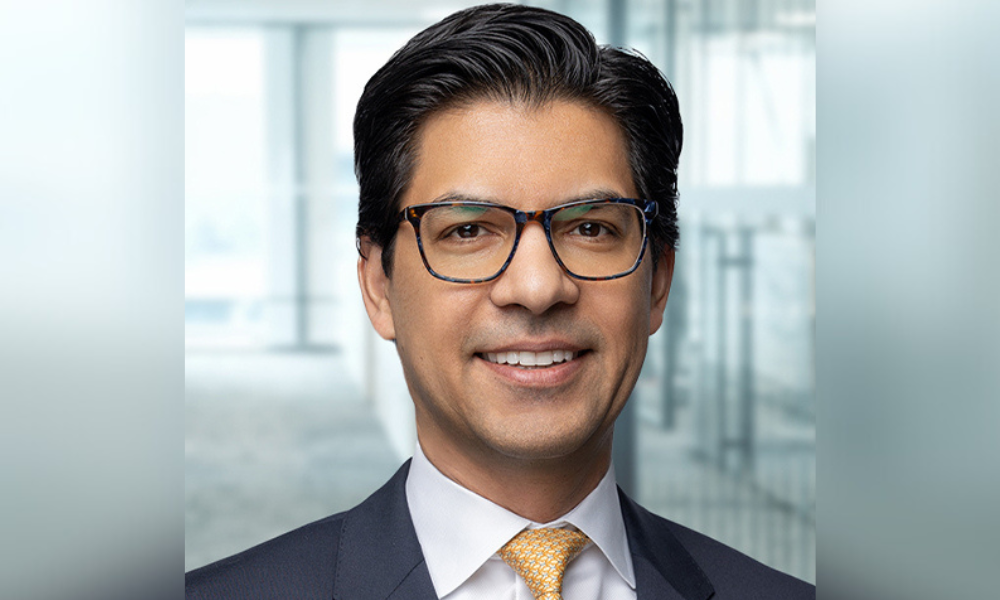In an exclusive interview with Wealth Professional, iShares head discusses the trends advisors should pay attention to
How is the ETF market developing in 2016 and what does the future hold? Wealth Professional sat down with Pat Chiefalo, head of Canadian product for BlackRock’s iShares business, to assess the landscape.
Paul Lucas: What is your opinion on the way the markets have developed since the beginning of the year?
Pat Chiefalo: 2016 has largely been characterized by big swings in market leadership, as we’ve seen risk moving off and on. The current risk-on sentiment has produced a rally in US equities, high yield fixed income, emerging markets equities, and commodities, with broad benchmarks covering these asset classes having recovered losses and now back to flat or slightly positive year to date. As an example, the S&P 500 Index, which was down -10.3 per cent in USD terms as of February 11, was up +0.8 per cent for the year as of March 18 on a total return basis. Oil in the US started the year in the mid-30s, hit a low of 26.05 on February 11 and then rallied to $41. Along with the price of crude, the Canadian dollar began the year at 72 cents, sank to 68 cents on Jan 20 and then rallied to 77 cents.
Paul Lucas: Are there any particular developments that Canadians should be paying attention to?
Pat Chiefalo: Given the Fed’s more dovish tone as it relates to the path of interest rate increases, and the impact this is having on the US dollar, one notable trend we are seeing is an increase in demand for currency hedged exposure to the US markets. To illustrate this, for Canadian-listed ETFs providing broad-based US equity market exposure, year-to-date we have seen +$643 million of asset flows into CAD-hedged versions of these exposures, versus outflows of -$87 million in the non-hedged versions.
In addition, the initial heighted volatility certainly triggered a flight to quality expressed by flows into government bond funds and cash. There is very much the likelihood of whipsawing taking place with the risk trade having begun to roll back in: there is renewed interest in equity, commodity and international assets. It’s important to remember that this knee-jerk type of reaction to short-term market events can wreak havoc on investor asset allocation plans and long term tracking towards their financial targets. To help investors who may be concerned with market volatility, but still want to stay invested, we are seeing increased adoption of minimum volatility funds, which seek to help dial down market risk, yet allowing investors to maintain exposure to equities, while at the same time delivering comparable market returns.
Paul Lucas: Tell me about the growth of the fixed ETF market and what impact it’s having?
Pat Chiefalo: The increasing adoption of fixed income ETFs is a trend we continue to observe. Given the inherent benefits of ETFs – transparency, real-time pricing, liquidity and low costs – which don’t readily exist in many parts of the fixed income markets today, it’s a growth we don’t see slowing down.
When we look at the numbers, it’s notable. Since 2008, assets in Canadian-listed bond ETFs have climbed by more than 1,100 per cent. More recently, since 2010, fixed income ETF AUM in Canada has increased at a compound annual growth rate of 27 per cent, from $8 billion at the end of 2010 to $28 billion at the end of 2015, it now represents over 30 per cent of total ETF AUM in Canada.
Paul Lucas: What are the typical concerns clients have regarding the ETF market and how do you address them?
Pat Chiefalo: Typical concerns we hear from clients have to do with a general lack of familiarity with trading mechanics, which we address through close engagement with our clients on trading best practices, and deep relationships with our market makers.
Often, most of the concerns are from lack of knowledge on the products. As we - and the industry - continue to engage with clients on product usage and ETF education, I think this will only improve. But, there is still work to be done. Less of a concern, and more of a question, is the topic of liquidity and how to understand these characteristics as they relate to an ETF.
Paul Lucas: What mistakes do you see clients making with their execution process?
Pat Chiefalo: The most common mistake observed is the use of market order types which, particularly for larger orders, does not provide for the level of price execution certainty and ETF liquidity sourcing that is achievable. Limit orders are always recommended when placing trades in ETFs, it help ensure investors trade at the level they want and protects against unusual market events that can happen with any listed stock product.
Another recommendation we often provide is to avoid trading ETFs during the opening and closing 15 minutes of market hours, as these time periods can often times be more volatile for the markets as a whole.
We also see some clients shying away from certain ETFs that may appear to be less liquid based on certain more conventional measures of liquidity – but given the multiple layers of liquidity embedded in the ETF structure, many of these ETFs may actually be more liquid than perceived. We encourage our clients to reach out to us whenever unsure about trading our products as we can help facilitate best execution.
Paul Lucas: Finally, what do you think is the future of the ETF markets?
Pat Chiefalo: It’s an exciting time for the ETF industry. As the fastest growing investment category in Canada, I only see opportunity and a strong growth trajectory. As existing users evolve and deepen their ETF usage to new users embracing ETFs in their portfolios, I see strong growth continuing for some time.
The climate is also right for it. With regulatory shifts requiring greater fee transparency with CRM2, evolving distribution and advisory models - like online investing and digital advice, to the development of smart beta ETF products, as efficient and cost-effective alternative sources of return, and finally new providers growing the category - the future is bright.
Paul Lucas: What is your opinion on the way the markets have developed since the beginning of the year?
Pat Chiefalo: 2016 has largely been characterized by big swings in market leadership, as we’ve seen risk moving off and on. The current risk-on sentiment has produced a rally in US equities, high yield fixed income, emerging markets equities, and commodities, with broad benchmarks covering these asset classes having recovered losses and now back to flat or slightly positive year to date. As an example, the S&P 500 Index, which was down -10.3 per cent in USD terms as of February 11, was up +0.8 per cent for the year as of March 18 on a total return basis. Oil in the US started the year in the mid-30s, hit a low of 26.05 on February 11 and then rallied to $41. Along with the price of crude, the Canadian dollar began the year at 72 cents, sank to 68 cents on Jan 20 and then rallied to 77 cents.
Paul Lucas: Are there any particular developments that Canadians should be paying attention to?
Pat Chiefalo: Given the Fed’s more dovish tone as it relates to the path of interest rate increases, and the impact this is having on the US dollar, one notable trend we are seeing is an increase in demand for currency hedged exposure to the US markets. To illustrate this, for Canadian-listed ETFs providing broad-based US equity market exposure, year-to-date we have seen +$643 million of asset flows into CAD-hedged versions of these exposures, versus outflows of -$87 million in the non-hedged versions.
In addition, the initial heighted volatility certainly triggered a flight to quality expressed by flows into government bond funds and cash. There is very much the likelihood of whipsawing taking place with the risk trade having begun to roll back in: there is renewed interest in equity, commodity and international assets. It’s important to remember that this knee-jerk type of reaction to short-term market events can wreak havoc on investor asset allocation plans and long term tracking towards their financial targets. To help investors who may be concerned with market volatility, but still want to stay invested, we are seeing increased adoption of minimum volatility funds, which seek to help dial down market risk, yet allowing investors to maintain exposure to equities, while at the same time delivering comparable market returns.
Paul Lucas: Tell me about the growth of the fixed ETF market and what impact it’s having?
Pat Chiefalo: The increasing adoption of fixed income ETFs is a trend we continue to observe. Given the inherent benefits of ETFs – transparency, real-time pricing, liquidity and low costs – which don’t readily exist in many parts of the fixed income markets today, it’s a growth we don’t see slowing down.
When we look at the numbers, it’s notable. Since 2008, assets in Canadian-listed bond ETFs have climbed by more than 1,100 per cent. More recently, since 2010, fixed income ETF AUM in Canada has increased at a compound annual growth rate of 27 per cent, from $8 billion at the end of 2010 to $28 billion at the end of 2015, it now represents over 30 per cent of total ETF AUM in Canada.
Paul Lucas: What are the typical concerns clients have regarding the ETF market and how do you address them?
Pat Chiefalo: Typical concerns we hear from clients have to do with a general lack of familiarity with trading mechanics, which we address through close engagement with our clients on trading best practices, and deep relationships with our market makers.
Often, most of the concerns are from lack of knowledge on the products. As we - and the industry - continue to engage with clients on product usage and ETF education, I think this will only improve. But, there is still work to be done. Less of a concern, and more of a question, is the topic of liquidity and how to understand these characteristics as they relate to an ETF.
Paul Lucas: What mistakes do you see clients making with their execution process?
Pat Chiefalo: The most common mistake observed is the use of market order types which, particularly for larger orders, does not provide for the level of price execution certainty and ETF liquidity sourcing that is achievable. Limit orders are always recommended when placing trades in ETFs, it help ensure investors trade at the level they want and protects against unusual market events that can happen with any listed stock product.
Another recommendation we often provide is to avoid trading ETFs during the opening and closing 15 minutes of market hours, as these time periods can often times be more volatile for the markets as a whole.
We also see some clients shying away from certain ETFs that may appear to be less liquid based on certain more conventional measures of liquidity – but given the multiple layers of liquidity embedded in the ETF structure, many of these ETFs may actually be more liquid than perceived. We encourage our clients to reach out to us whenever unsure about trading our products as we can help facilitate best execution.
Paul Lucas: Finally, what do you think is the future of the ETF markets?
Pat Chiefalo: It’s an exciting time for the ETF industry. As the fastest growing investment category in Canada, I only see opportunity and a strong growth trajectory. As existing users evolve and deepen their ETF usage to new users embracing ETFs in their portfolios, I see strong growth continuing for some time.
The climate is also right for it. With regulatory shifts requiring greater fee transparency with CRM2, evolving distribution and advisory models - like online investing and digital advice, to the development of smart beta ETF products, as efficient and cost-effective alternative sources of return, and finally new providers growing the category - the future is bright.



